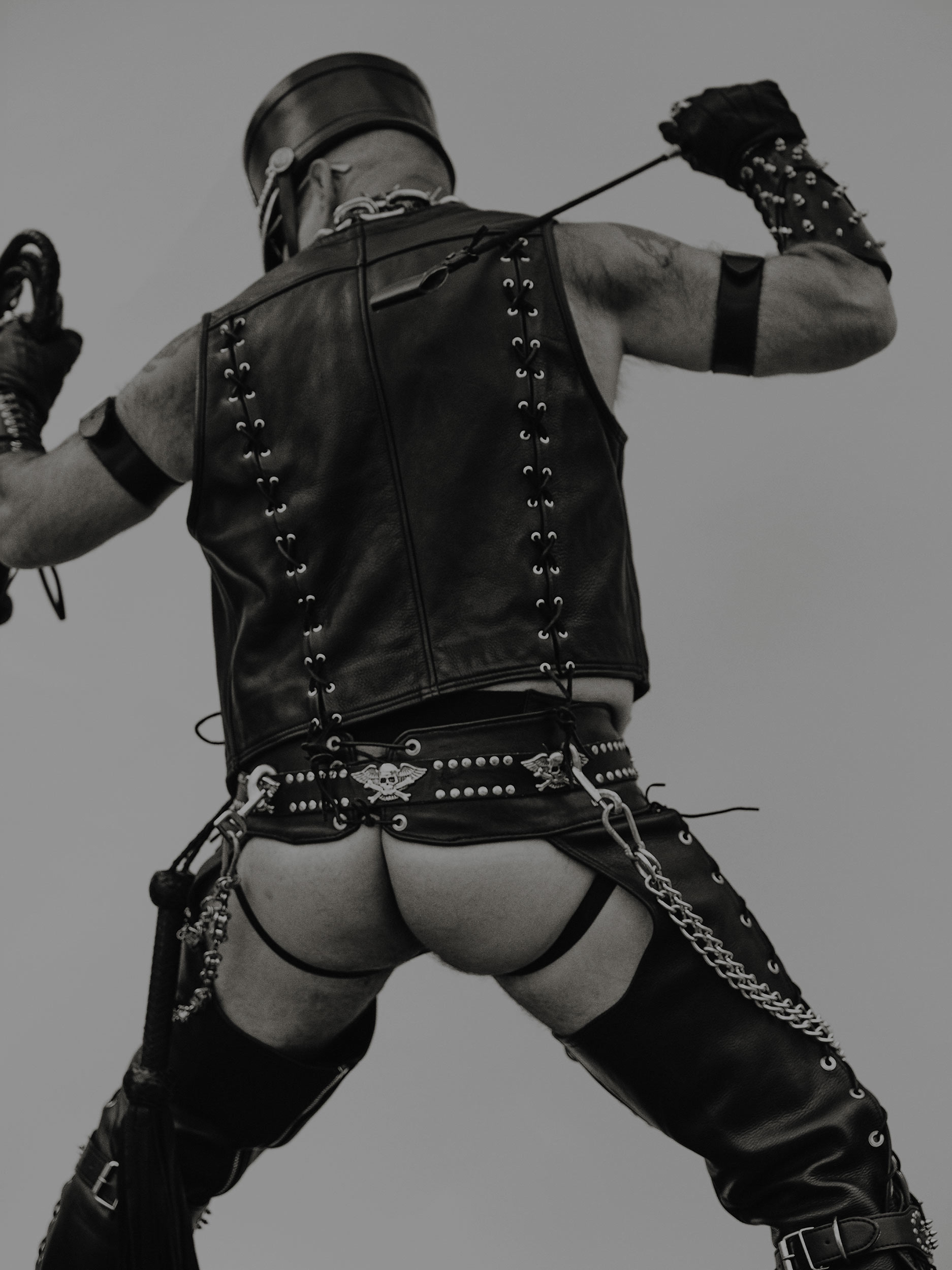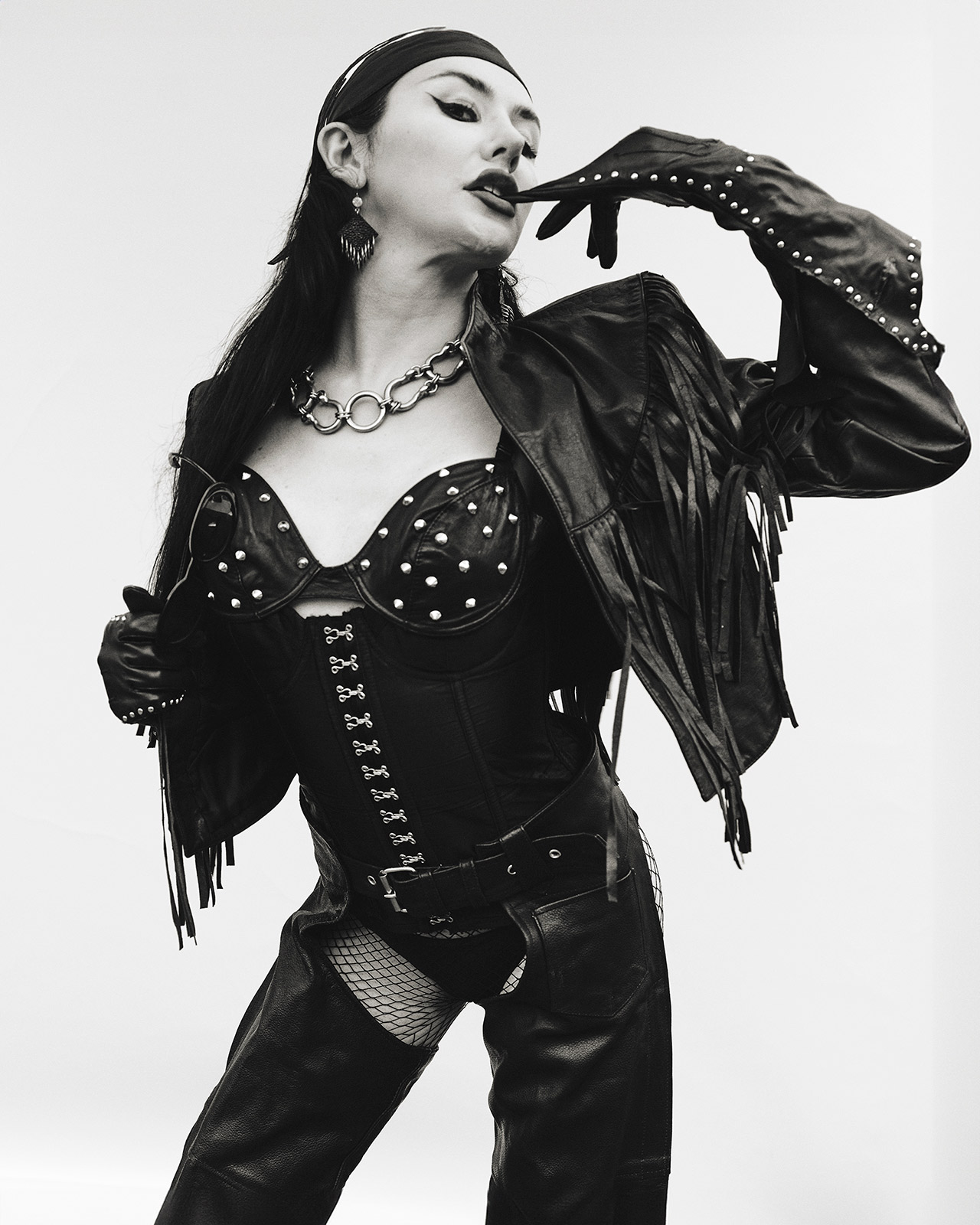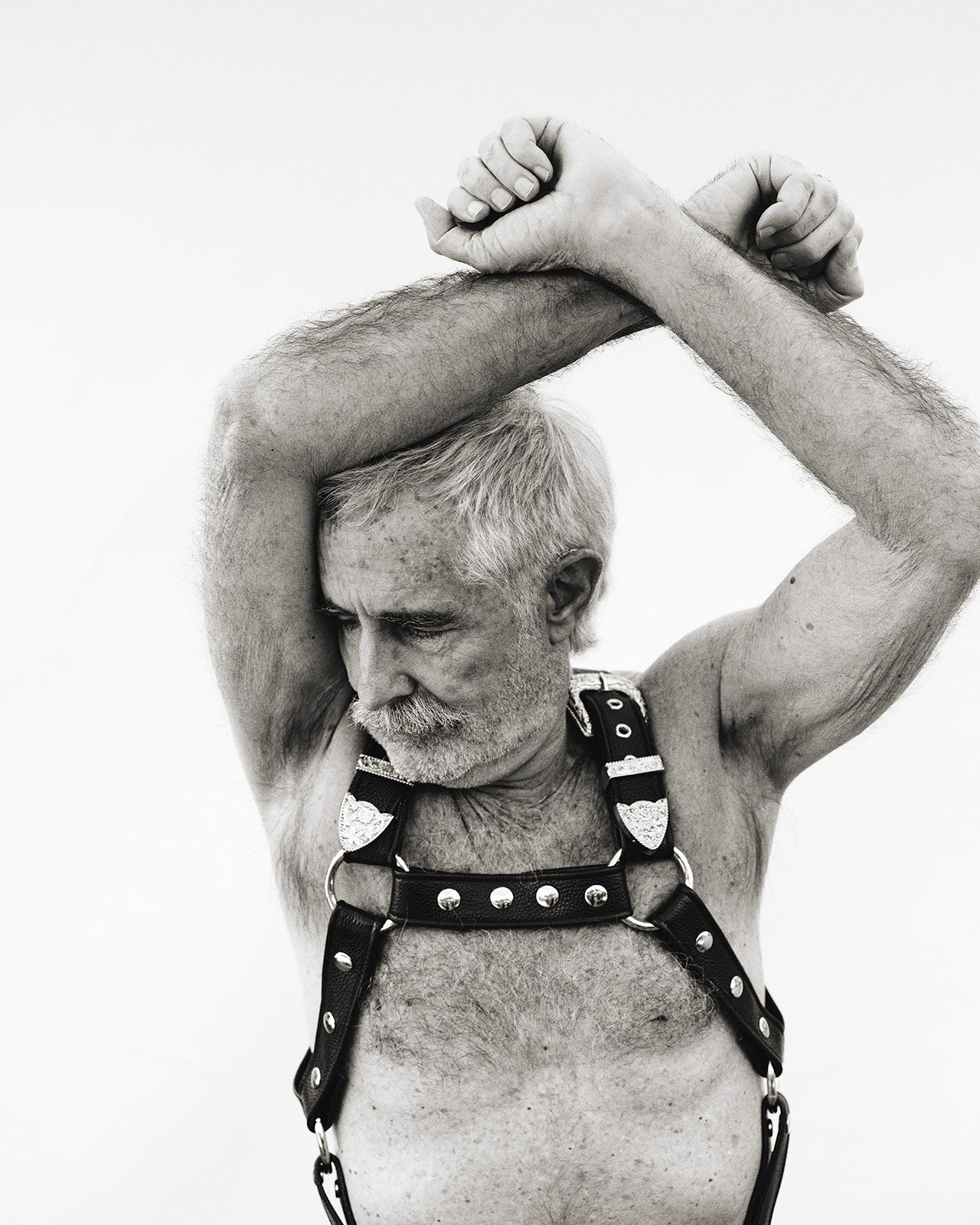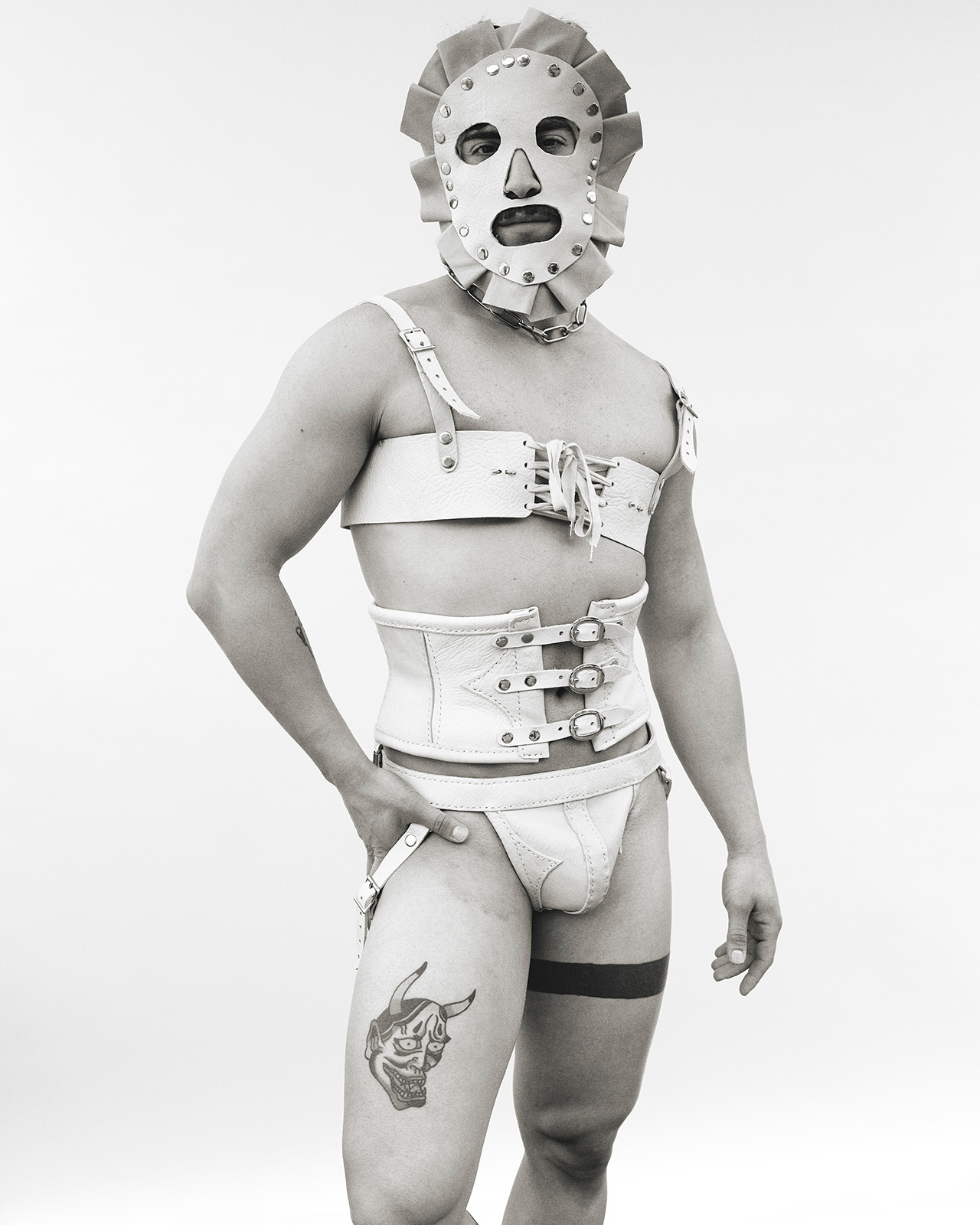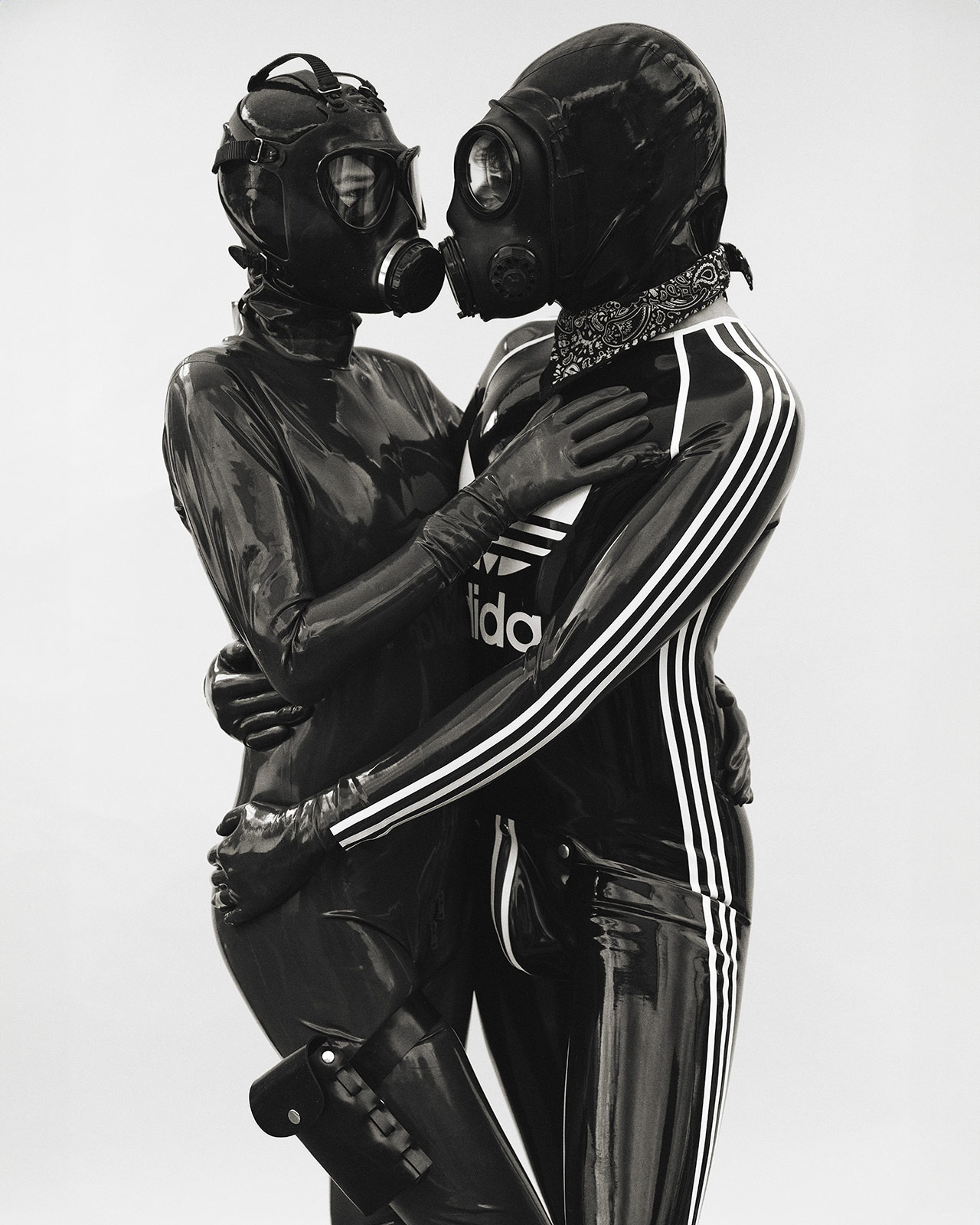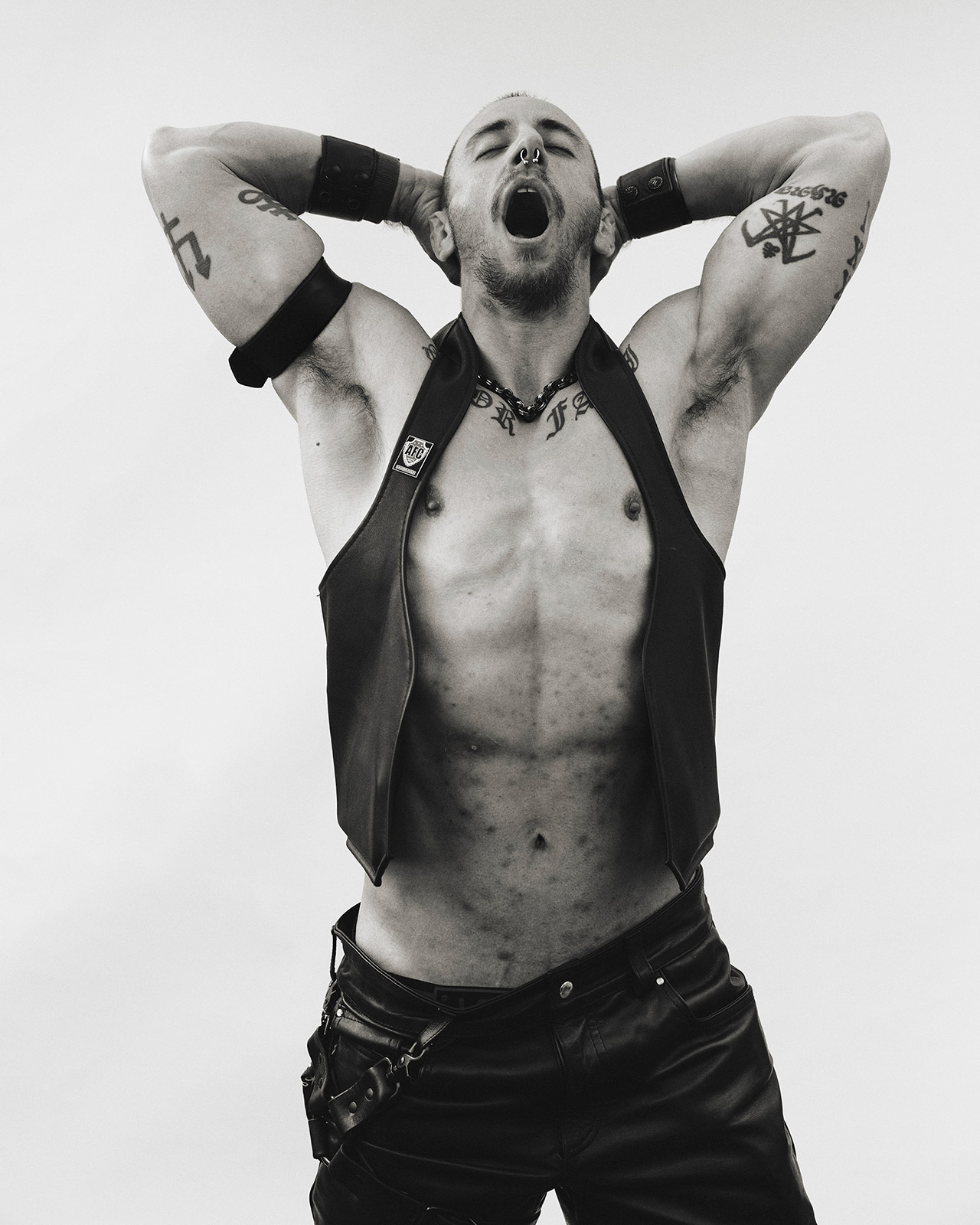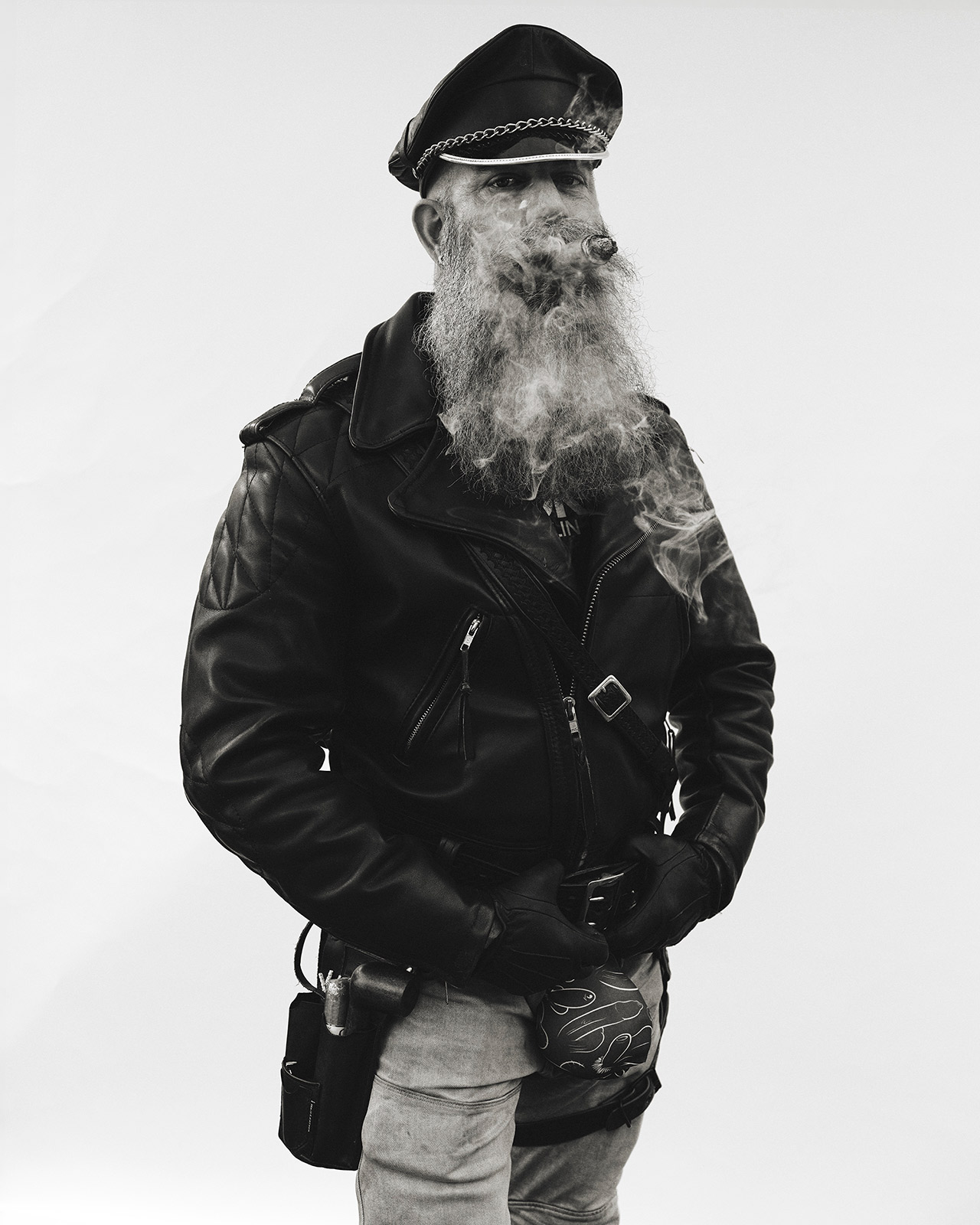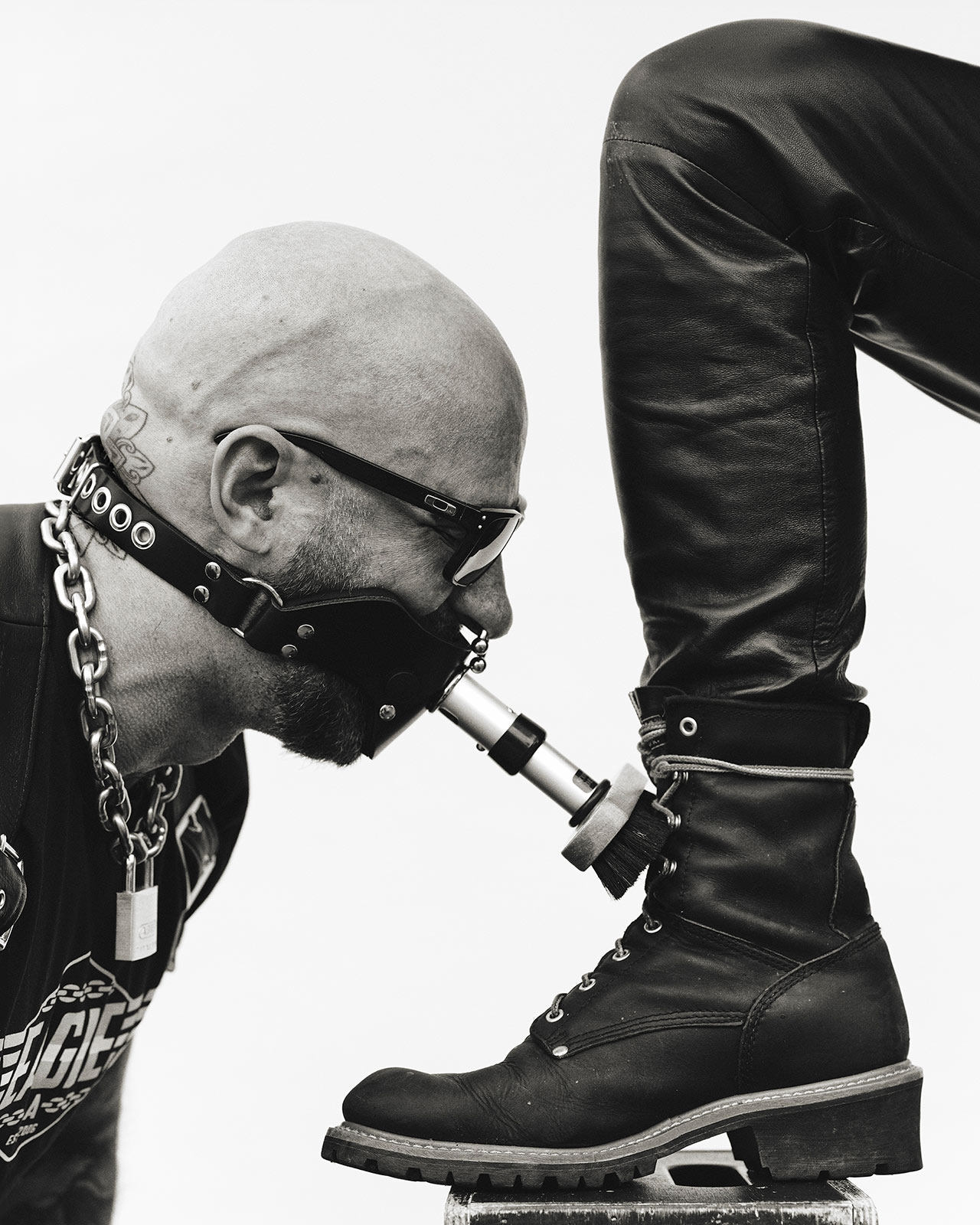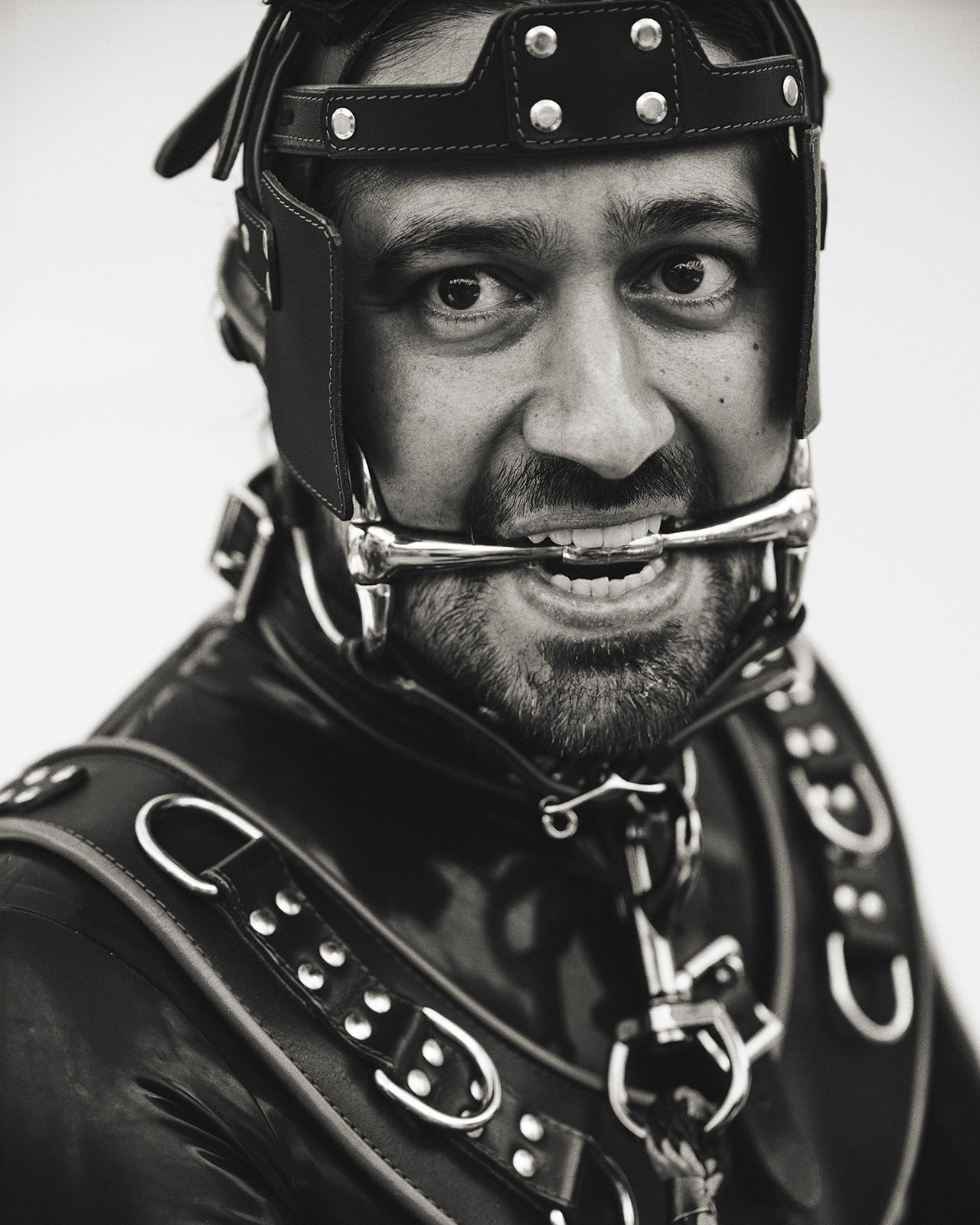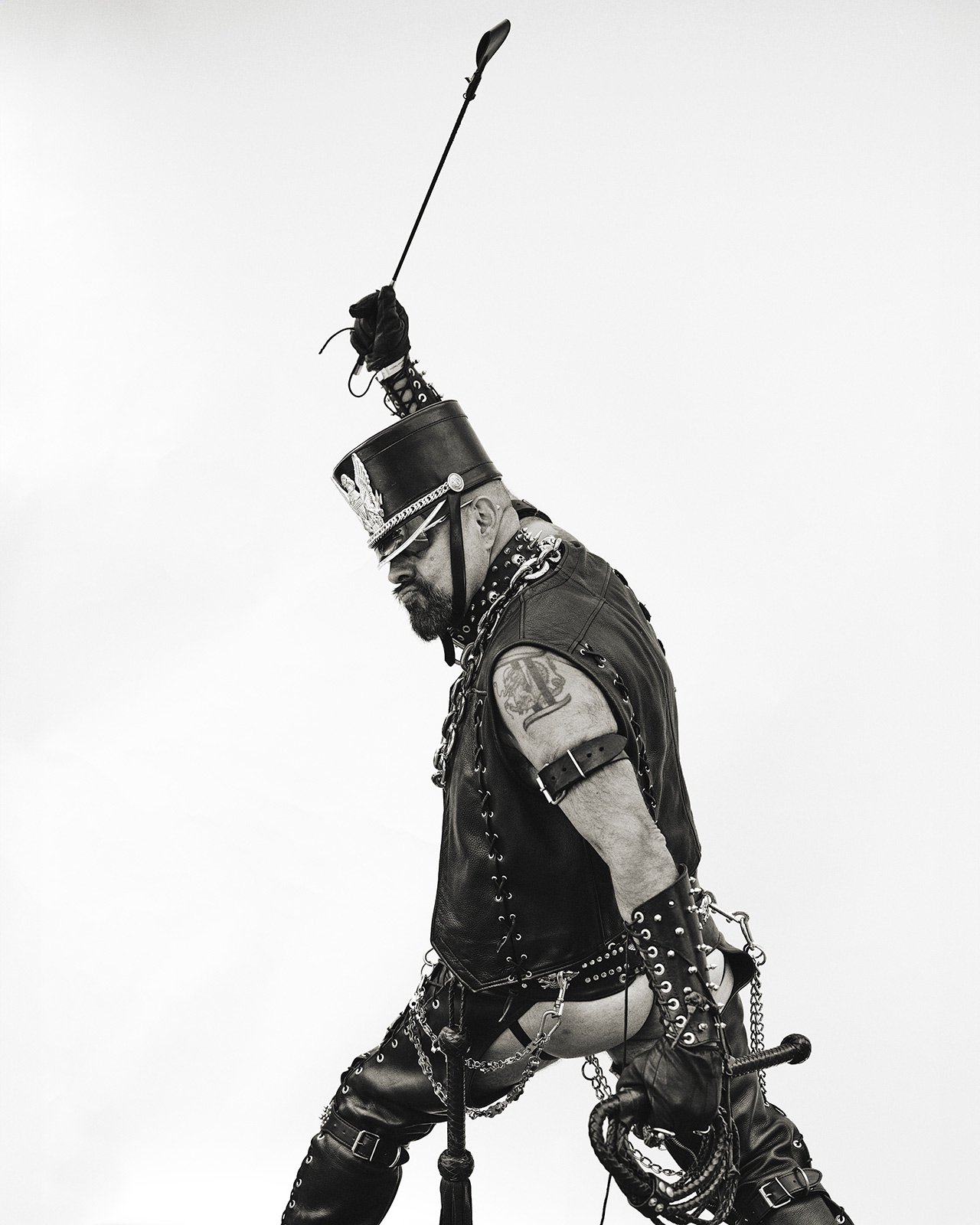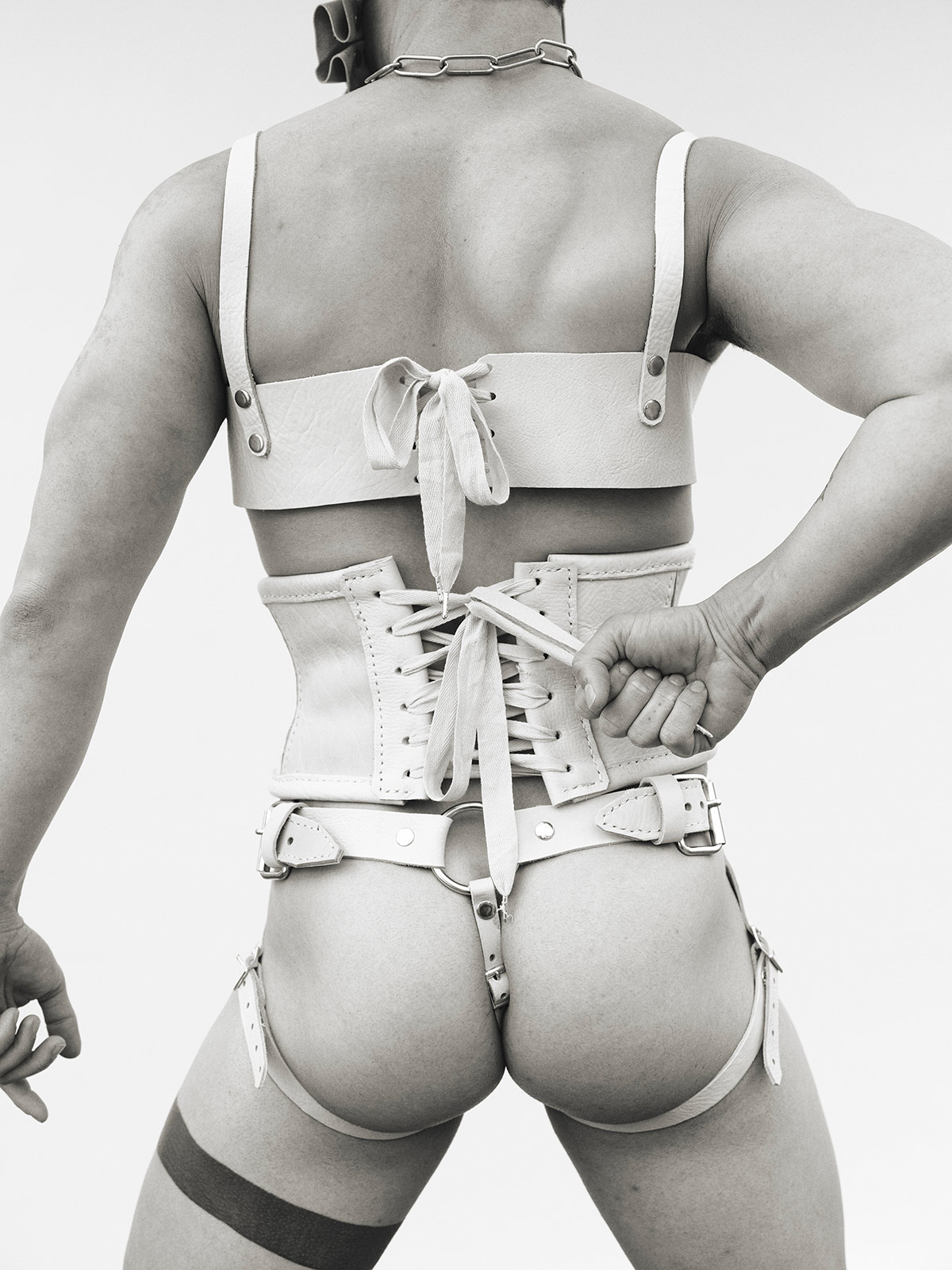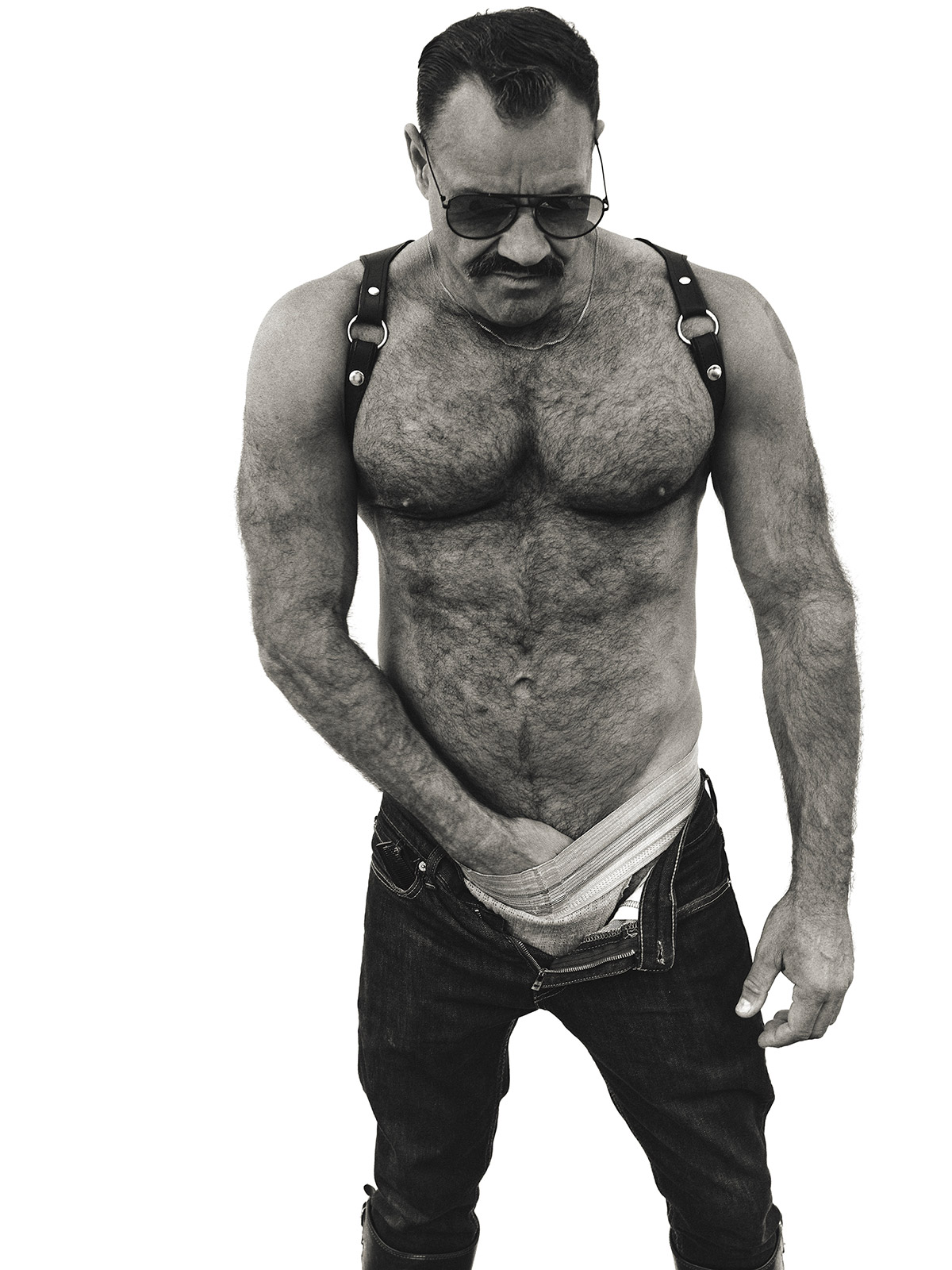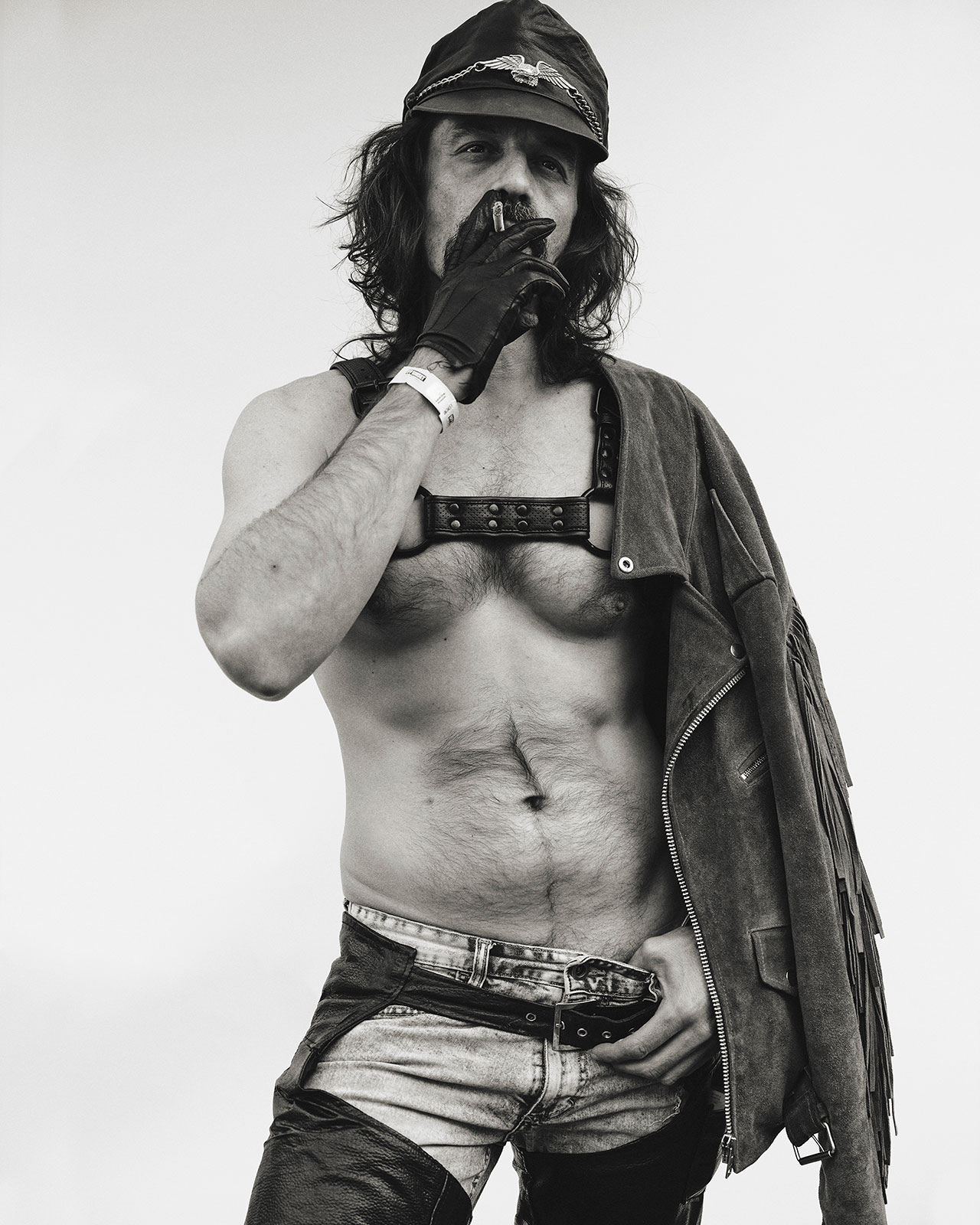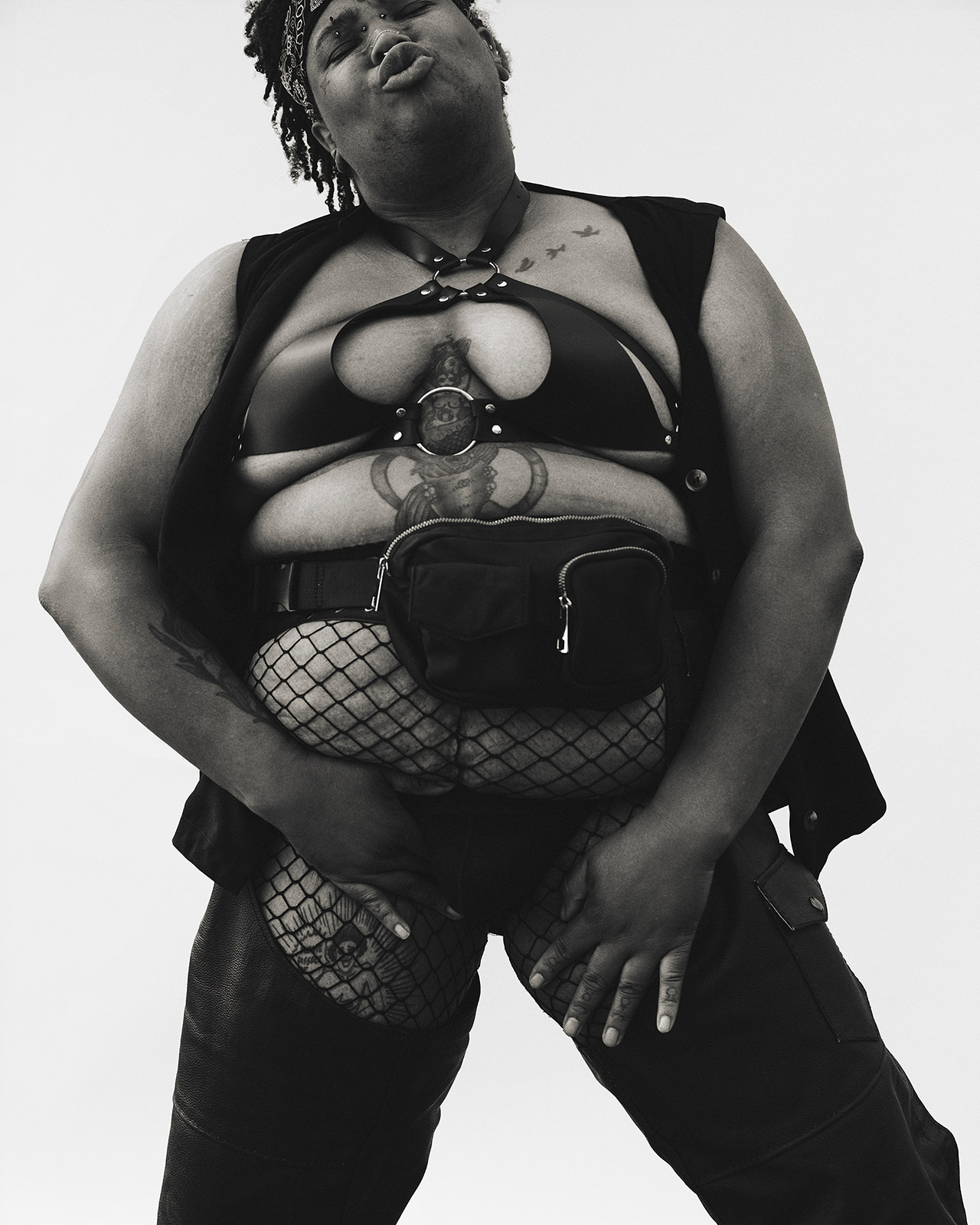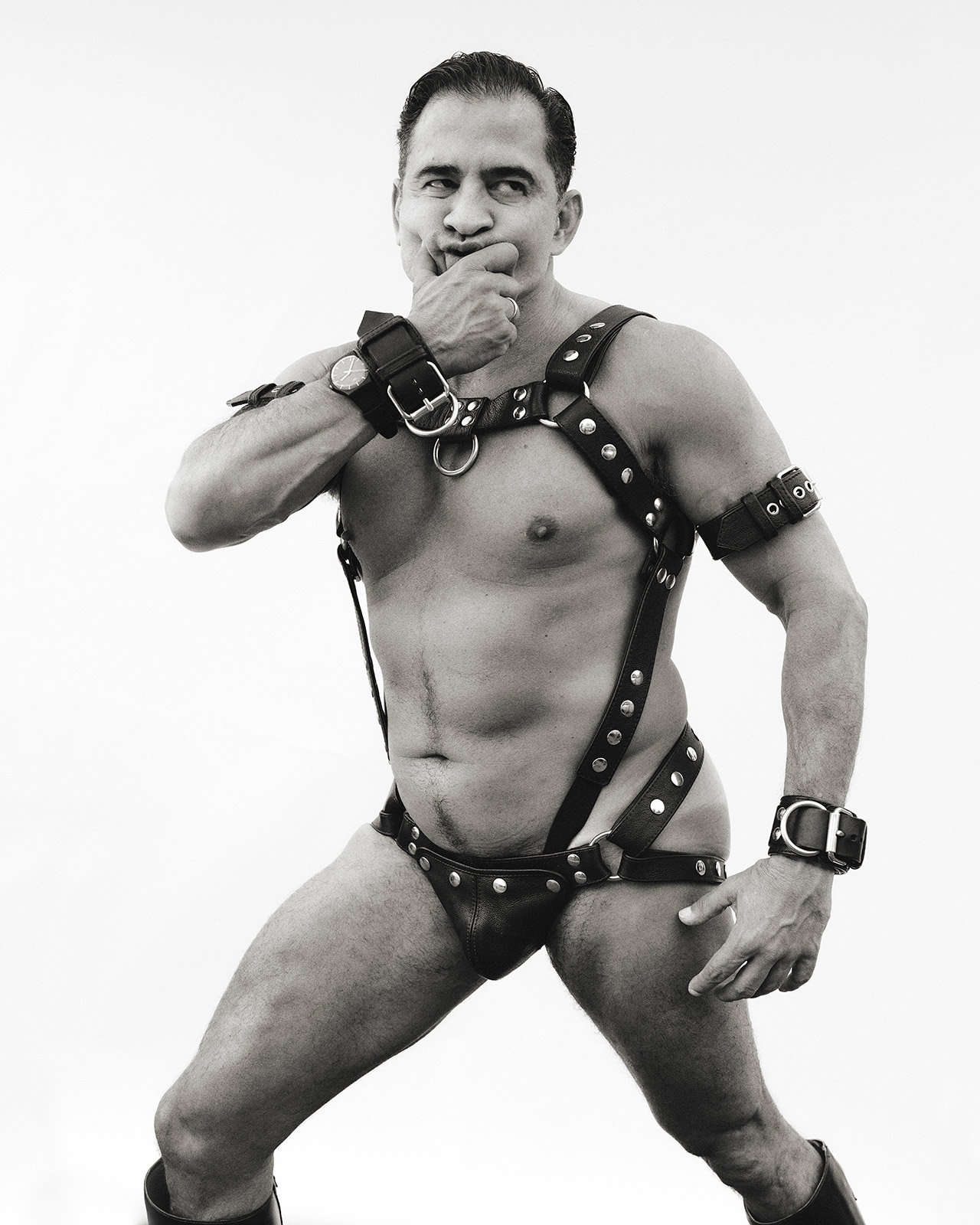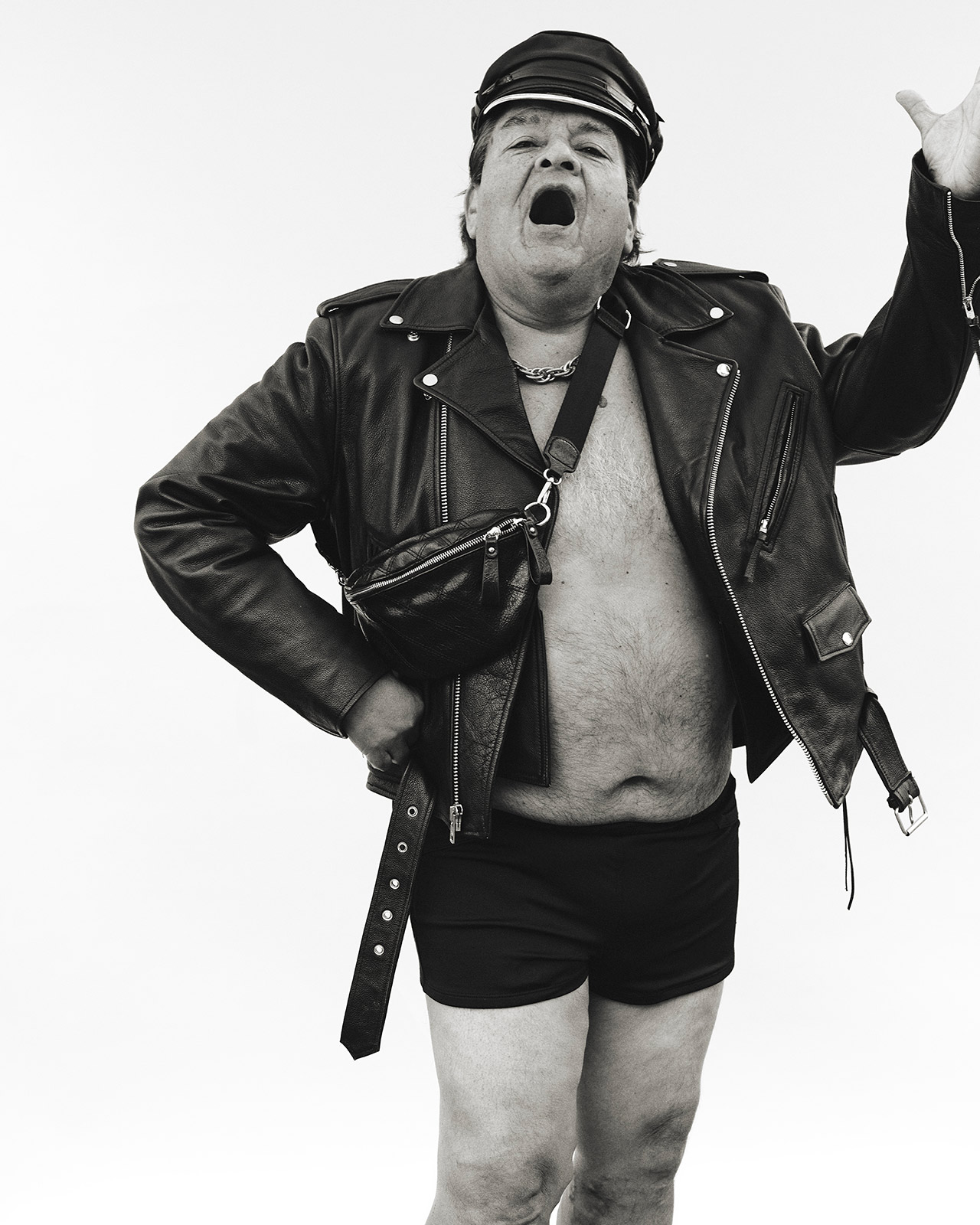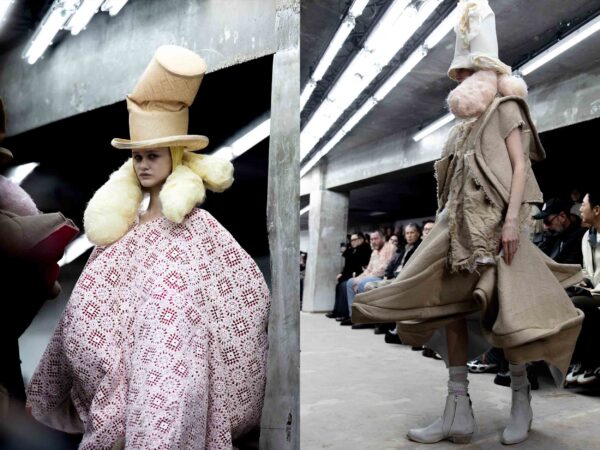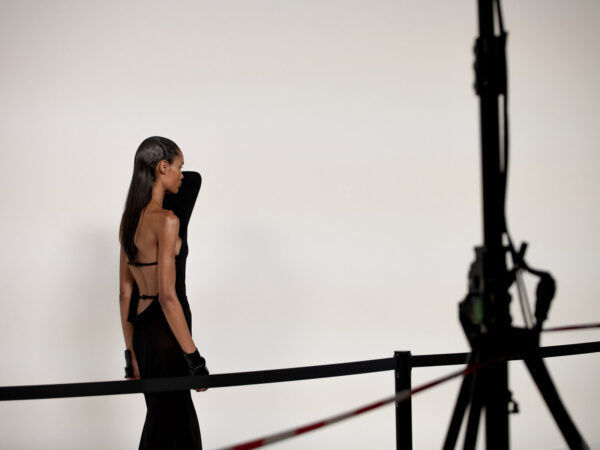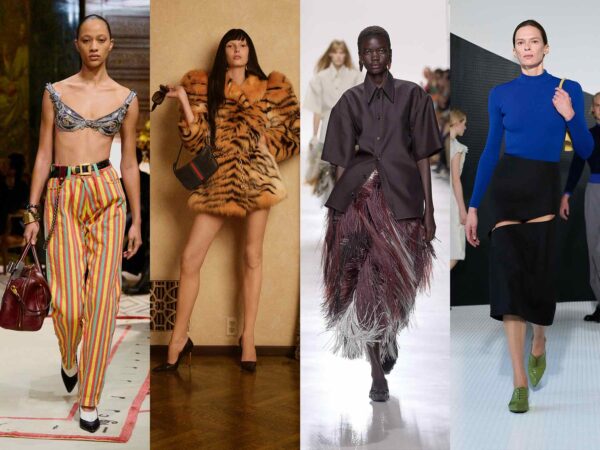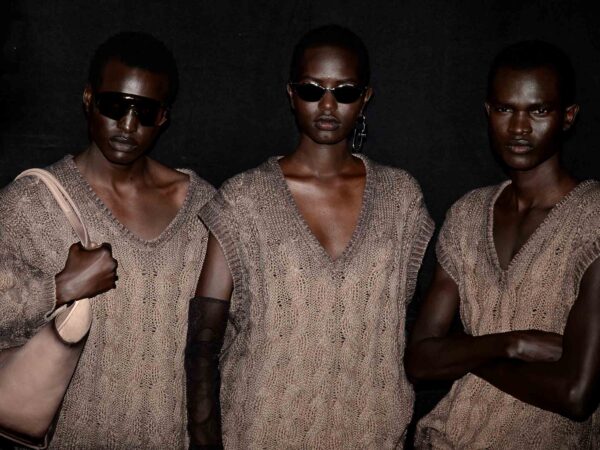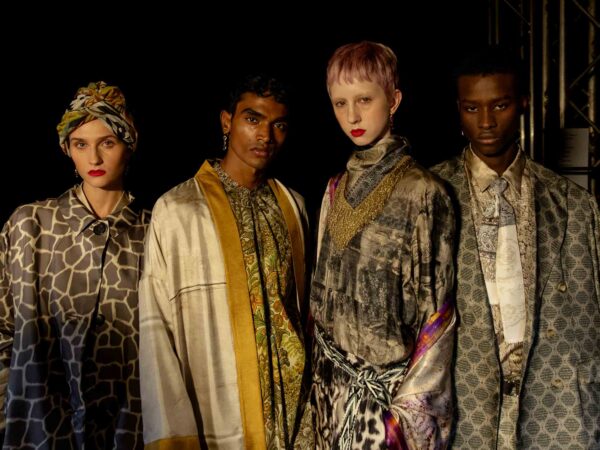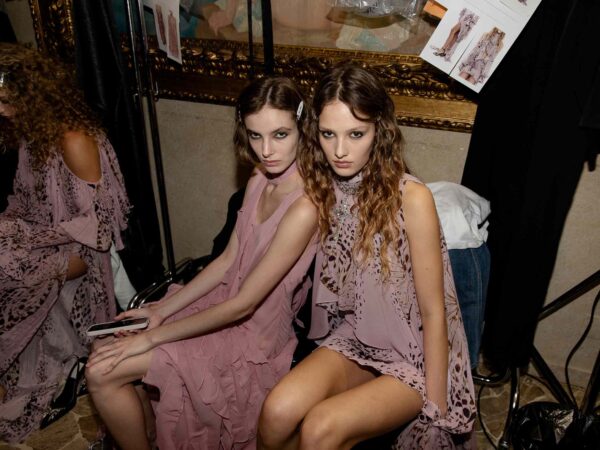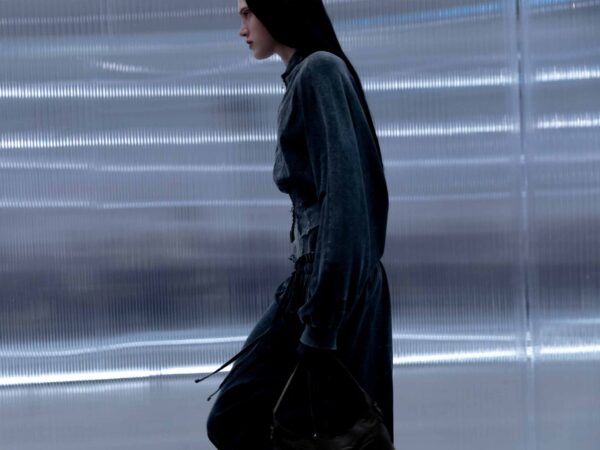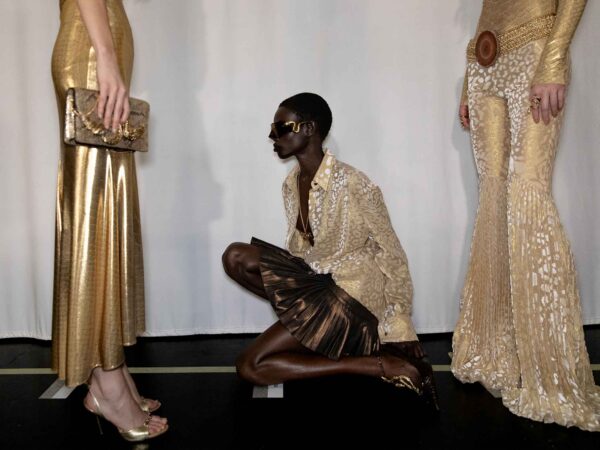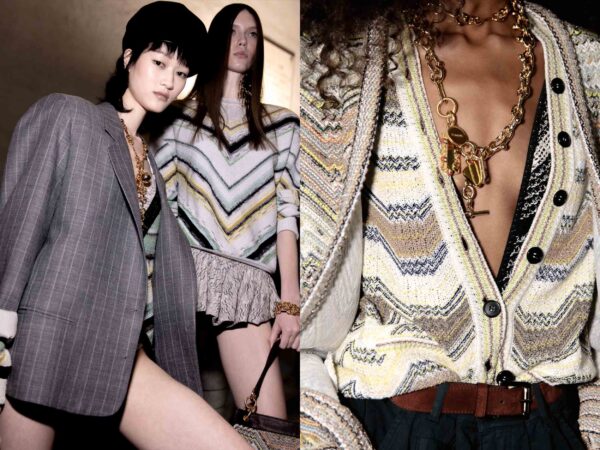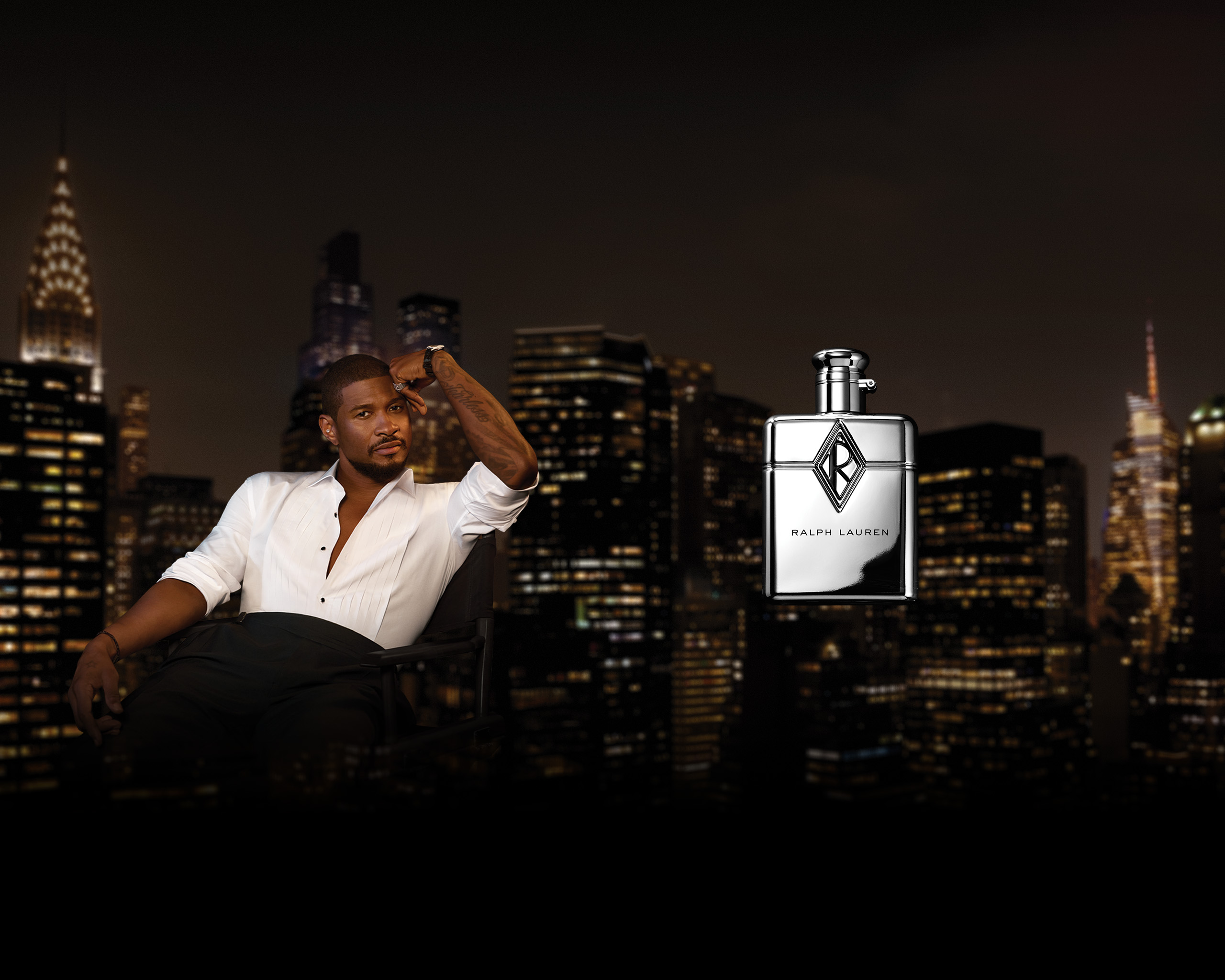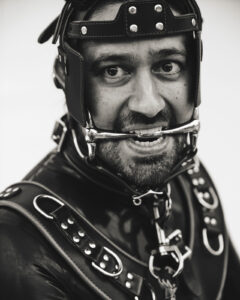Writer Pedro Vasconcelos traces leather’s journey from underground queer spaces to high-fashion runways, while photographer Jonny Marlow documents the origins of this aesthetic at LA’s legendary Eagle bar
Two creative perspectives converge on the same subject: the leather daddy aesthetic, sprung from underground queer communities and emulated by high fashion. Fashion writer Pedro Vasconcelos traces this iconography’s filtration from darkrooms to catwalks, examining fashion’s ongoing fascination with leather culture’s visual codes. Meanwhile, celebrity portrait photographer Jonny Marlow makes a radical departure from his usual practice, setting up his camera outside The Eagle– LA’s legendary leather bar– to document the community at the genesis of this aesthetic.
At the bar’s annual ‘Off Sunset Festival’, Marlow snapped candid portraits of the leathermen and women who call this corner of West Hollywood home. The subculture is not as far removed from fashion as you might expect. “A lot of these pieces are all couture,” he explains of his subjects’ elaborate ensembles. “They have all been custom made, either by the subjects or very expensive leather makers all over the states.” But Marlow was more taken by the leathermen’s vulnerability than their gear. The experience transformed his approach to photography: “It changed the way that I want to work honestly, because these people were just so uninhibited and so free… In the industry, everybody’s kind of obsessed with classic beauty and not looking foolish, and these boys were just, like, free.”
Together, these works reveal the full grain of leather culture’s influence—from Vasconcelos’s analysis of fashion’s appropriation to Marlow’s intimate portraits of the people for whom leather is second skin.
To be homosexual online is to have photos of Alexander Skarsgård in thigh-high Saint Laurent SS25 boots at Cannes shoved down our throats. As I flip between his viral red carpet look and his earlier photocall ensemble—a lethal combo of Loewe leather pants and a skin-tight vintage Tom of Finland t-shirt depicting a faceless boot pressed into a gaping mouth—I can think of only one thing: leather daddies. Skarsgård’s outfits are engineered to arouse thirst. He was at Cannes for the premiere of Pillion, a movie where he plays the dom in a relationship as freaky as it is emotionally enriching. My psychosexual reaction to celebrity-stylist Harry Lambert’s masterful execution was exactly his plan all along. This continues Skarsgård’s streak of provocative looks (who could forget the premiere of Infinity Pool, when the actor crawled down the red carpet leashed by Mia Goth).
I was equally parched when that same pair of boots came down the runway 28 times in a 37-look collection. For Saint Laurent Fall 2025, creative director Anthony Vaccarello proposed a meeting between the founder of the house and Robert Mapplethorpe; an encounter that would likely take place in a bathroom stall, as Vaccarello chose to portray it through wader boots grazing the crotches of sharply tailored suits. And, while Mapplethorpe’s work is a fixture in recent fashion history—collaborations in the last ten years range from Raf Simons to Zara—here, it wasn’t his work being lauded, but his personal iconography. The artist’s deep ties with the BDSM community, both professionally and personally, crystallized his public persona in a typical leather daddy ensemble: all jet-black leather moto jacket, pants, and a sailor cap. It goes without saying that Mapplethorpe didn’t invent the look. He documented and, allegedly, played around in it, but he didn’t define it.
“Regardless of its origins, leather culture turned authority into erotic iconography.”
It is speculated that the subculture dates back to motorcycle clubs formed by gay veterans after World War II. As a direct response to the mainstream’s idea of the queer man as effeminate, yester-gays did what we still do best: they dressed for the part they wanted. They drew from military and law enforcement uniforms, they cuntified them—broadened the shoulders, cinched the waist, plumped the ass, and bulged the crotch. Regardless of its origins, leather culture turned authority into erotic iconography. Through the work of Finnish artist Touko Laaksonen, otherwise known as Tom of Finland, the leather daddy look was ingrained in the queer vocabulary. Over time, the aesthetic was coded as a full-blown language of desire, utilizing garments to represent different roles and rules.
I’ll let the historians posit, I’m here to state facts: it’s a hot look. Through artists like Mapplethorpe and Laaksonen, the image slinked out of seedy corners and into the mainstream’s consciousness. Fashion designers alike have helped permeate the leather daddy figure in the masses’ visual lexicon. In fashion, the appeal is understandable—leather culture wears clothing as language. Through the leather daddy look, hypermasculinity is performed through otherwise inconspicuous garments. Leather jackets and pants aren’t inherently kinky on the rail, it’s in their combination and styling that gendered costume emerges. Case in point: George Cortina recently styled Brad Pitt in the same boots for GQ, but in a heterosexual fishing context, the boots lose their queer edge.
It would be grossly naive to attribute the prevalence of leather daddy iconography to its symbolic potential alone. Most male designers are homos. And their cultural proximity to leather culture means its visual elements inevitably seep into their work. Take Thierry Mugler, the Daddiest of them all. His truly iconic Spring/Summer 1992 collection featured literal leather daddies in tight vests and circulation-defying shorts, while Fall/Winter 1995 corseted leatherwomen into bug-like aliens. Sometimes the veil was omitted entirely—as when his motorcycle-inspired bustier, complete with handlebars and a side view mirror, strolled down the runway.
As Mugler cruised the Parisian catwalks, Gianni Versace turned Milan into a leather bar. For Fall/Winter 1992, objectively hot men stood against a blank wall in a beautifully lit dark room, “looking.” And who could forget Jean Paul Gaultier’s nautical dreamboats, all of which could’ve been pasted directly from a Tom of Finland-drawn Physique Pictorial. To speak of leather sexuality on the runway is to scream Tom Ford’s name. And while leather daddies were hardly seen amongst his twinky cast, their visual codes were constantly trafficked. Ford’s man wasn’t cruising in back alleys, rather setting up a heavy-duty sling in his penthouse boudoir.
The list could easily expand: Galliano, McQueen, DSquared2, Rick Owens, Ludovic de Saint-Sernin. Who can forget Haider Ackermann’s debut at Tom Ford, parading male models in head-to-toe leather and leather lesbians—a criminally underrepresented subculture—in tuxedo shirts.
“Tight pants alone do not a leather daddy make. But the fantasy lives on, not just in dark rooms but in Saint Laurent press releases and Loewe lookbooks.”
Just because so many do it, doesn’t mean they do it right. The leather subculture involves a community and lifestyle with its own customs and rules. Taking visual cues from leather culture without its context is appropriation, even if taken by queer people themselves. Fashion sanitizes leather culture into an aesthetic, largely diluting its essence without entirely blunting its deviant bite. Speaking to a genuine leather daddy for this story, he noted that very few brands have done it right. For example, he directed me to a Loewe’s Pre-Spring/Summer 2025 campaign, in which he was featured, shot by Juergen Teller. Three “leather daddies”, so identified in the photo’s caption, hold the Puzzle Fold Tote. And, while their inclusion is merely tokenistic—the same campaign included a fully geared diver, a silver-suited knight, and two bodybuilders in micro speedos—the acknowledgement offered to them as three men from the culture they’re representing is a respectful gesture. But disrespect is to be expected from queer men. Many a circuit gay (derogatory) has strapped on a harness and fancied himself a leather daddy.
So no, not every boot is a statement. Tight pants alone do not a leather daddy make. But the fantasy lives on, not just in dark rooms but in Saint Laurent press releases and Loewe lookbooks. When leather shows up on the runway, in ad campaigns, or stretched across a celebrity at a photocall, it is rarely just fashion. Even stripped of context, cleaned up, boxed, and sold at SSENSE, the charge persists. Leather, like queerness, slips through every crack in the culture. At times, it sneaks in, disguised as tailoring. Other times, it kicks the door down in thigh-high boots. Either way, we recognize it. We feel it. And we nod, respectfully, a little turned on.
Street Casting Camraface. First Assistant Michael Irwin. Special Thanks to The Eagle Los Angeles and Off Sunset Festival.


